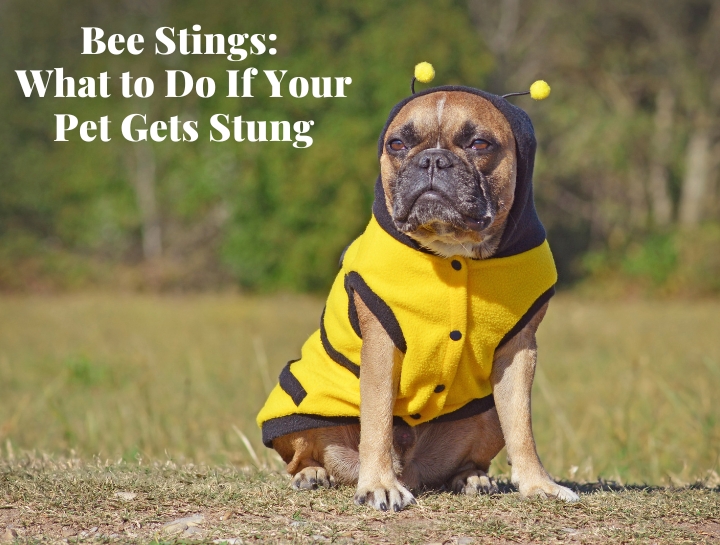Bee Stings: What to Do When Your Pet Gets Stung

It's springtime, and that means bees are buzzing around, collecting pollen, and making honey. Bees that are foraging for nectar or pollen will rarely sting unless stepped on or they feel threatened by being roughly handled—but what happens when your furry pal gets stung by one of these busy bees?
What happens during a bee sting?
When a bee stings, it pierces the skin with its barbed stinger and releases venom. Bee venom contains proteins that cause an immune response. The inflammation causes pain and swelling around the sting site.
Signs that your pet has been stung by a bee can include:
- Whining
- Limping
- Swelling
- Drooling
- Gnawing
- Pawing at the area that was stung
- Hives or welts
- Pain when touched
My pet got stung by a bee, now what?
If you know or suspect your pet has been stung by a bee, closely monitor them for any reaction, especially for the first hour after the sting.
The location of the sting can make a great difference in observed symptoms. If your pet was stung inside the mouth, or the bee was swallowed, they may experience:
- Shaking of the head
- Drooling
- Repeated lip licking
- Coughing or gag reflex
- Rapid breathing or wheezing
- Vomiting or diarrhea
Swelling is the most common side effect and can be completely normal, so it’s not necessarily an indication of an anaphylactic reaction. You should, however, keep an eye on your pet when swelling occurs, especially on the neck or face. If the swelling persists or worsens after a couple of hours, contact your veterinarian.
Severe swelling of the neck or face can interfere with swallowing or breathing. In addition, a pet may experience wheezing or other kinds of respiratory distress, difficulty standing, or seizures. In any of these cases, get your pet to the veterinarian as soon as possible.
Contact your vet right away if your pet received multiple bee stings—higher levels of venom can produce a severe reaction.
The stinger is still embedded in the skin, what do I do?
If your pet has been stung and the stinger remains behind, do not attempt to remove it using tweezers as this may force more venom into the wound. Instead, use a credit card to scrape the stinger out.
Is my pet going into anaphylactic shock?
The lungs, liver, and heart are all affected by anaphylactic shock. In cats, the respiratory system is the major area of impact. In dogs, unlike in other domestic animals, it’s the liver and gastrointestinal tract that are most affected by anaphylactic shock, rather than the lungs. That is why gastrointestinal distress is a major sign to look for in the case of a bee sting to a dog, as well as respiratory distress.
When a dog does go into anaphylactic shock, excessive levels of histamines in the body can lead to:
- Pale gums
- Diarrhea and/or vomiting
- Drooling
- Pale gums
- Cold paws
- Seizures
- Coma
If you observe any signs of anaphylactic shock, call your veterinarian immediately.
Is there anything I can do for my pet’s pain?
Applying a cold compress to the sting can help alleviate swelling and pain. Also, a diluted mixture of water and baking soda applied to the area can help reduce pain.
If your pet is licking or scratching at the sting, consider using an e-collar to prevent access to the wound. Such licking and scratching can delay the healing process and possibly introduce infection.
DO NOT give your pet an antihistamine without speaking with your veterinarian first. It’s a good idea to call the vet ahead of your visit, in case they want you to administer a medication that you may already have on hand.
What if my pet had no issues with past bee stings?
Even if your pet has been stung in the past and had little to no reaction, that doesn’t mean they won’t have a reaction if they’re stung again. The reverse is also true: a bad reaction in the past doesn’t necessarily mean they’ll have a bad reaction in the future but this does mean you should monitor them carefully.
It’s always best to err on the side of caution and consult your veterinarian when your pet has been stung by a bee. Provide them with your pet’s symptoms and heed their advice.
Are there ways to prevent bee stings?
While preventing your pets from being stung by a bee can be challenging, there are a few things that you can do to help lessen the risk. Try to keep your fur baby away from the flower beds in your yard and avoid flowers when walking your pet. Practice diverting your dog’s attention and ensure they come when called, to help in a situation where you see them going after bees.
Be sure to keep an eye on your furry friends during bee season and buzz over to the vet if you suspect they've been stung!
If you have any questions about bee stings or would like to set up an appointment, call us at (330) 722-0041!
Article written and contributed by Dr. Amanda Brezicki, DVM, Northeast Animal Hospital in St. Petersburg, FL, May 2023.
